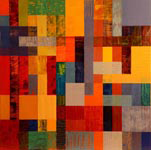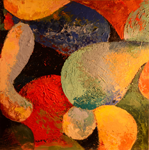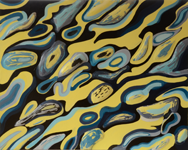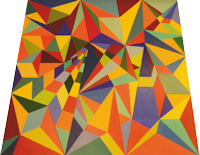
| Home | About | Galleries | Shows | Recent Work | Contact |
Mary Laucks: Contemporary Abstract Painter
The Artist's Galleries

Hard Edge
By "hard edge" I mean that the colours in the painting are separated by sharp edges (usually created by taping). My interest in this style of painting is primarily in the effects that colours create in relation to each other. Instead of blurring coloured areas together in a painterly way, I make the coloured areas more distinct by separating them. I have also experimented with creating texture within the coloured areas to create more variation within the colours.Visit the Hard Edge Gallery

Texture
Texture in paint creates depth both by illusion and by actual three-dimensional height above the surface. Both techniques create complexity in the painted surface. I enjoy attempting to create surfaces that mimic the complexity of natural surfaces - rocks, water, soil, cell structures in plants. Many natural objects have the same complexity at many scales - from far away a rock may have a certain complex shape, - as you approach the rock, different patterns and forms emerge, but still as complex. Close-up you can see regions of differentiated materials and trace geological processes -still as complex. I think paintings are more interesting when they mimic this fractal characteristic in nature.Visit the Texture Gallery

Topography
I have begun to develop a technique using dry wall plaster and acrylic paint that allows both carving and layering of coloured plaster in order to create actual and implied three dimensionality on a two dimensional surface. I work plaster with various tools, both when it is wet and after it dries, and I apply many layers within one painting, sanding between layers. Sometimes the plaster is combined with various textured acrylic media. The presence of bulky shapes emerging out of the plane of the painting adds complexity to the interpretation of the relations of the objects in the paintingVisit the Topography Gallery

Non rectilinear
Composition within a non-rectangular frame is more complex because there is no one ratio of sides that defines the space of the painting. Objects within the boundary have certain relationships to each other and objects within the painting have relationships with the boundary that depend on orientation. Also there may be more than one ratio of sides if the painting is not rectangular. With a square or rectangular piece, there are at most only four important orientations and the internal composition adopts this four-fold symmetry. Representational paintings usually have only one orientation. But in non-rectangular paintings, all orientations can be equally important. It was challenging and exciting to create designs that work in multiple orientations and have no reference to a rectangle. When you look at these pieces, ask yourself what effect the non-rectangular boundary has on the composition -- and enjoy the paintings!Visit the Non rectilinear Gallery
Recent work
Galleries > Hard Edge - Texture - Topography - Non rectilinear
Contact the artist by email: mlaucks@telus.net
| Home | About | Galleries | Shows | Recent Work | Contact |